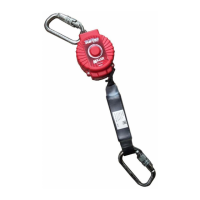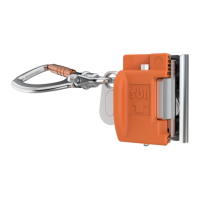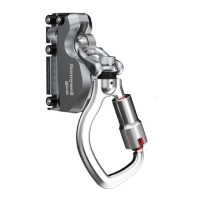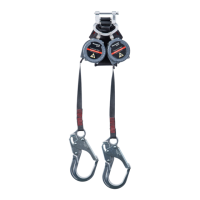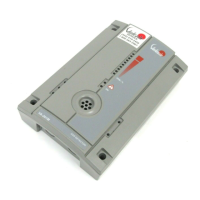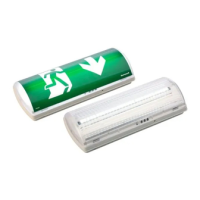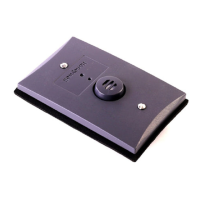13
If a SelfRetracting Lifelines with a
maximum arrest distance of less than
42 in (1m) and is being used by a worker
weighing between 130 lb (140,6kg) and
420 lb (190,5kg), the maximum arrest
distance allowed per standards [42 in
(1m)] must be used when calculating fall
clearance distance.
If there is any question about calculating
fall clearance distance, please contact
Honeywell Technical Service:
8008735242 (press 4)
5.0 Inspection and
Maintenance
5.1 Inspection and Operation Testing
Honeywell Safety Products inspection
requirements incorporate the criteria
established by current safety standards.
The inspection criteria for the equipment
shall be set by the user’s organization,
such that it equals or exceeds the criteria
required by the manufacturer and the
standards with which the organization
elects to comply.
CAUTION: Always wear gloves when
inspecting cable lifelines; broken
strands can cause injury!
Equipment shall be thoroughly inspected
and operationally tested by the user
before each use, and additionally, by a
competent person, other than the user,
at regular intervals of no more than one
year. If any of the following conditions is
observed removed from service:
9 Absence or illegibility of markings/
labels
9 Absence of any elements affecting
the equipment form, fit or function
9 Evidence of defects in or damage to
the cable or webbing lifeline including
fraying, cuts, broken strands, burns,
corrosion, kinks, chemical attack,
abrasion, alteration, excessive aging,
excessive wear, and loose, broken or
pulled stitches
9 Operational damage to the lifeline
9 Evidence of defects in or damage to
hardware elements including cracks,
breaks, rough or sharp edges, defor-
mation, corrosion, chemical attack,
excessive heating, pitted surfaces,
alteration, and excessive wear
9 Operational damage to the hardware
9 Evidence of defects in or damage to
the housing and/or loose/missing
fasteners
9 Evidence of deployed or activated fall
load indicators
9 Failure to lock when the lifeline is
pulled out rapidly, so as to simulate
a fall arrest
*ANSI Z359.14 and CSA Z259.2.2 - provide
additional inspection requirements based on
type of use and conditions of use. Refer to ANSI
Z359.14: “6.1 Inspection” and CSA Z259.2.2:
Table 2 “Inspection and revalidation”. (*See note
in section 5.2 Maintenance.)
Retraction - With the device in a mounted
position, test the lifeline retraction and
tension by pulling out several feet of the
lifeline and allow to retract back into the
unit. Always maintain a light tension on the
lifeline as it retracts. The lifeline should
pull out freely and retract all the way back
into the unit. If the lifeline does not pull out
smoothly or sticks when retracting, pull all
the lifeline out of the housing and allow
it to retract slowly under tension. Do not
use the unit if the lifeline does not retract
properly.
Maximum Fall Clearance Required for Foot Level TieOff Application
(up to 5-ft below harness D-ring* Class 2)
Maximum Fall Clearance Need
Lateral edge distance
User Weight
(including clothing,
tools, & PPE)
0 ft
(0 m)
1 ft
(0,3 m)
2 ft
(0,61 m)
3 ft
(0,91 m)
4 ft
(1,22 m)
5 ft
(1,52 m)
6 ft
(1,83 m)
Up to 310-lb
(140,61kg)
16 ft
(4,88m)
16,5 ft
(5,03m)
17 ft
(5,18m)
17,58 ft
(5,36m)
18,16 ft
(5,53m)
19,08 ft
(5,81m)
20 ft
(6,10m)
310 lb to 420 lb
(140,61kg to 190,51kg)
18 ft
(5,49m)
18,5 ft
(5,64m)
19 ft
(5,79m)
19,58 ft
(5,36m)
20,16 ft
(6,14m)
21,08 ft
(6,42m)
22 ft
(6,71m)

